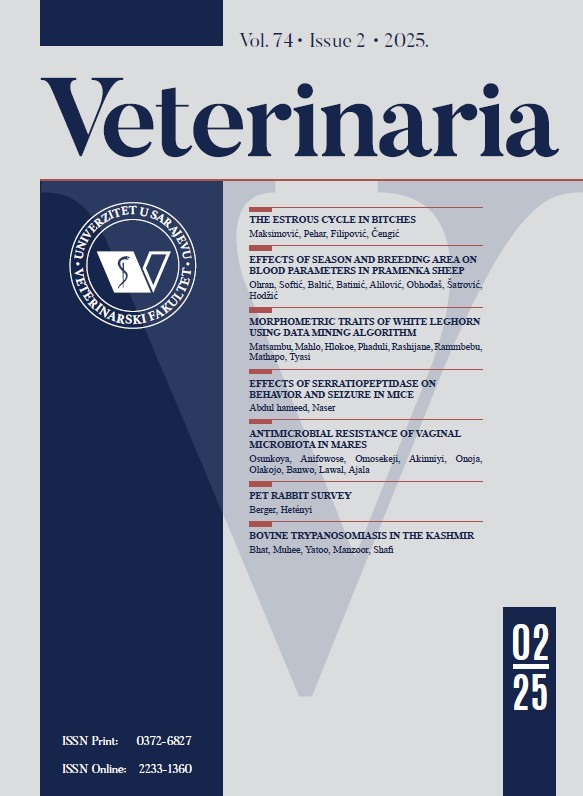Anatomy of the female urogenital system of the West African Giraffe (Giraffa camelopardalis peralta)
DOI:
https://doi.org/10.51607/22331360.2022.71.3.321Keywords:
Giraffe, kidney, morphology, morphometr, ovaryAbstract
The knowledge of the anatomy of organs of the urogenital system is vital in understanding aetiologies of anomalies. To this end, morphology and morphometry of the organs of reproduction and urine formation, from autopsies of two adult non-gravid West African giraffes (Giraffa camelopardalis peralta) at the Faculty of Veterinary Medicine, University of Ilorin, Ilorin, Nigeria were studied. In situ, two encapsulated kidneys were found to be retroperitoneal and asymmetrically pressed against the dorsal abdominal wall on each side of the aorta and caudal vena cava by perirenal fats, blood vessels and other abdominal viscera. The right kidney was more cranial than the left. Cross- sectionally, the kidneys depicted an outer dark-brown cortex and an inner light pink medulla. The cranial pole of the kidney was characterised of poorly developed renal pyramids whose papilla coalesced into a renal crest. Conversely, there were distinct renal pyramids in the caudal pole, each separated by minor calyx that collected into a major calyx leading to the renal pelvis. A funnel-shaped renal pelvis continued outside a hilus as a tubular structure, the ureter which passed caudally in the retroperitoneal space along the dorsal abdominal wall to reach the pelvic cavity, and ended at the dorsolateral surface of the neck of the urinary bladder, ventral to the uterus. The neck of the urinary bladder was continuous with the urethra. Paired ellipsoidal shaped, laterally flattened ovaries were located close to the middle of the lateral side of the pelvic inlet. Sagittally, the ovaries revealed centralized medulla and peripheral cortices. Paired flexuous oviducts, comprising a cranial funnel-shaped infundibulum, middle ampulla and caudal isthmus, which terminated at the cranial part of the uterine horn emanated from the ovaries. The uterus was located entirely in the pelvic cavity, had a cranial paired uterine horn that fused caudally to form the middle short uterine body. Uterine horns and body presented three rows of erect, leaf-like papillae (caruncles) arranged in straight fashion on the endometrium. The uterine cervix was a short, firm, thick muscular tube. Its lumen was narrowed by three rings and thick mucus plug. The vagina was long and wide located between the dorsal rectum and ventral bladder in situ. Its mucosa presented shallow longitudinal folds which were less prominent at its middle. The vulva presented a short caudal tubular continuation of the vagina as the vestibule; it was horizontally oriented and demarcated from the vagina by a shallow transverse groove. The external urethral orifice opened on its cranio-ventral surface forming a midline longitudinal groove that extended to the clitoris. The vulva also presented two labia that met at the dorsal and ventral commissures. It was concluded from the study that female urogenital anatomy of the giraffe shows semblance with those of other ruminants with some variations.

Downloads
Published
How to Cite
Issue
Section
License
Copyright (c) 2022 Alhaji Zubair Jaji Jaji, Kenechukwu Tobechukwu Onwuama, Chikera Samuel Ibe, Sulaiman Olawoye Salami, Esther Solomon Kigir

This work is licensed under a Creative Commons Attribution 4.0 International License.







